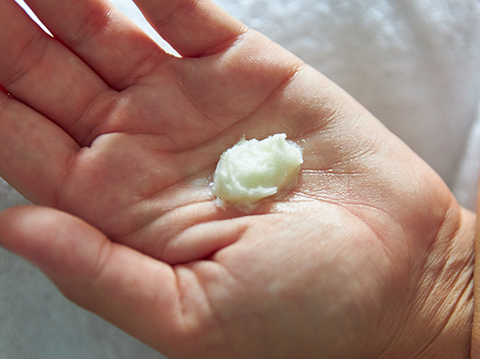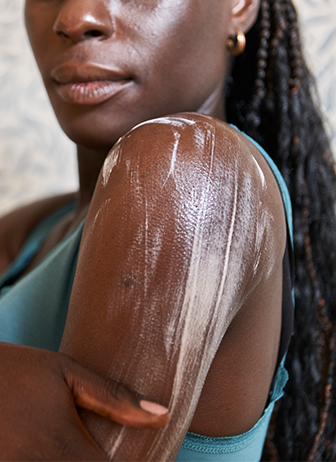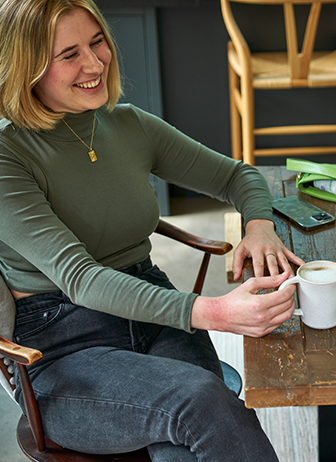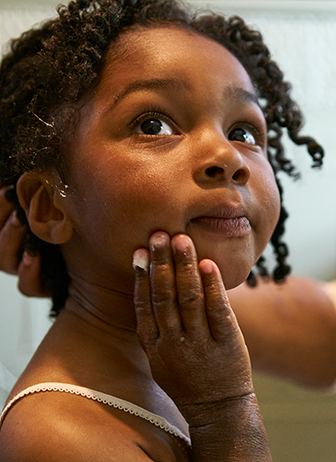An Introduction to Ichthyosis
Find out more about Ichthyosis, certain types, symptoms and treatments in our helpful guide.
(Pronounced ick-thee-oh-sis)
What is Ichthyosis?
Ichthyosis is a skin condition that pops up when a confused gene affects the rate skin regenerates – so old skin cells take too long to shed, or new cells reproduce faster than the old ones can keep up!¹
These slow-moving cells often make skin feel rough, dry, thick and scaly, and can cause all sorts of other symptoms too, dependent on the type of Ichthyosis or how severe it gets.
1 in 250 people in the UK have Ichthyosis in its mildest, most typical genetic form², and there are many other more severe, rarer varieties too. So if you’ve experienced any of the symptoms, you’re definitely not alone.
Nusrit – AKA Nelly – Shaheen is one of the oldest known person alive with Harlequin Ichthyosis in the UK, and she now works as a sports coach for children with disabilities. You can find out more about her story here, and in the Channel 5 documentary Extraordinary People.
What causes Ichthyosis?
Ichthyosis vulgaris or IV as it is often abbreviated too (the most common type) is genetic – which means there’s no specific cause, it simply runs in the family! It’ll usually make itself known in early childhood⁷ so parents who know they have a history can keep an eye out for it. However, it can also occur later in life, which has some other causes.
Some people develop acquired Ichthyosis in adult life, most commonly as a result of old age – the older we get, the drier our skin gets too. However, on rare occasions it can be associated with other conditions like kidney disease; metabolic factors like a thyroid condition; a deficiency in vitamin A, or even environmental elements like chlorine or air conditioning⁸.
And while the weather isn’t what causes Ichthyosis, both IV and the acquired form are very reactive to temperature. You might find your skin is even drier when the weather is cold, dry and windy in winter, or in reaction to excessive heat⁹.
What are the symptoms of Ichthyosis?
With so many types of Ichthyosis, there are lots of different symptoms – which can affect more than the skin. Here are some of the most common to look out for, and some of the more severe ones to be aware of too.
Common symptoms of Ichthyosis Vulgaris:
- Dry and rough feeling skin and the look of fine, light grey scales on the arms and legs. This often appears in children before the age of one.
- Thicker, more lined skin on the palms and soles of the feet.
- Often linked with, and sometimes misdiagnosed as, Eczema.
Symptoms of other rarer types of inherited Ichthyosis:
- Inflamed, scaly-feeling skin across the whole body
- Blistered skin
- Drooping lower eyelids
- Mild hair loss
- Tight skin on the fingers
Other symptoms of severe Ichthyosis:
- Thicker skin can reduce the ability to sweat, so people may experience overheating.
- Dry skin can make it painful to move certain parts of the body.
- Cracked, split skin can become infected.
- If skin is tight or sheddding around someone's ear or eyes, it can affect their hearing or eyesight.¹⁰
How should you treat Ichthyosis?
Many people ask, is there is a cure for Ichthyosis? While there isn’t a magic pill or injection you can have to take it away, there are lots of different ways to treat it and smooth out that rough-feeling skin.
This starts with a daily skincare routine to help prevent the build-up of those slow-moving cells, which includes moisturisers and using emollients instead of soap, shower gel or bubble baths. In some cases retinoids, antiseptics and antibiotics will are also used to manage Ichthyosis. Ointments, creams, lotions and bath oils all make good emollients, so speak to your GP about the best place to start.
Does Ichthyosis have an impact on your life?
With the right treatment and an effective skincare routine, someone with Ichthyosis can still do all the activities they love the most – whether that’s sports, swimming, sunbathing or anything else you can think of, Just remember your SPF (at least factor 25) for the great outdoors, and keep your moisturiser on-hand, just in case...
That’s the most common Ichthyosis questions, answered. If you’re not sure where to start with emollients and moisturisers, Epaderm creams and ointments are clinically proven emollient options which can be for daily Ichthyosis treatment.
Find out more about Ichthyosis
if you’d like more information, tips or support, these websites are all great resources with even more insight on the condition:
The Ichthyosis Support Group: https://www.Ichthyosis.org.uk/
The British Skin Foundation: https://knowyourskin.britishskinfoundation.org.uk/condition/Ichthyosis/
More Skin Types
Epaderm Library
Our website is jam-packed full of useful information from our skin blogs, user case studies to our in-depth FAQs. Discover more by clicking on the relevant section!References
¹https://www.nhs.uk/conditions/ichthyosis/
²https://knowyourskin.britishskinfoundation.org.uk/condition/ichthyosis/
³https://www.nhs.uk/conditions/ichthyosis/
⁴https://knowyourskin.britishskinfoundation.org.uk/condition/ichthyosis/
⁵https://knowyourskin.britishskinfoundation.org.uk/condition/ichthyosis/
⁶https://knowyourskin.britishskinfoundation.org.uk/condition/ichthyosis/ & https://www.ichthyosis.org.uk/Pages/FAQs/Category/what-is-ichthyosis
⁷https://www.ichthyosis.org.uk/Pages/FAQs/Category/what-is-ichthyosis
⁸https://www.ichthyosis.org.uk/Pages/FAQs/Category/what-is-ichthyosis
⁹https://www.ichthyosis.org.uk/Pages/FAQs/Category/what-is-ichthyosis
¹⁰https://www.nhs.uk/conditions/ichthyosis/
¹¹https://www.nhs.uk/conditions/ichthyosis/
¹²https://www.ichthyosis.org.uk/Pages/FAQs/Category/treatments-and-caring-for-ichthyosis

















